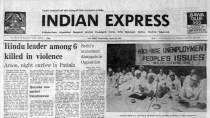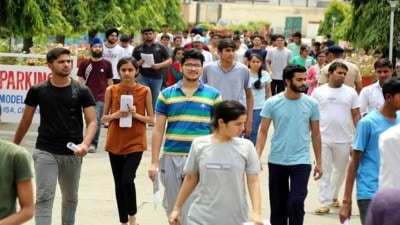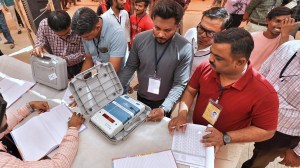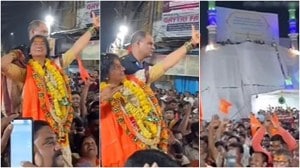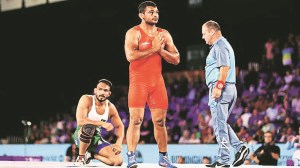- India
- International
Incentives to advance India-US partnership are stronger than ever before
The 2+2 dialogue comes in the backdrop of a structural shift in great power politics and turbulence in the global economic order.
 The dialogue is taking place three weeks after the foreign ministers of the Quad — or the Quadrilateral Security Framework — met in Tokyo. (Illustration by C R Sasikumar)
The dialogue is taking place three weeks after the foreign ministers of the Quad — or the Quadrilateral Security Framework — met in Tokyo. (Illustration by C R Sasikumar)Coming amidst China’s continuing aggression on the Ladakh frontier, the 2+2 dialogue between the defence and foreign ministers of India and the United States in Delhi this week marks an important moment in bilateral relations. It also takes place amidst a profound structural shift in great power politics as well as turbulence in the international economic order intensified by the coronavirus pandemic.
The four ministers, Rajnath Singh and Subrahmanyam Jaishankar, Mike Pompeo and Mark Esper, would want to reflect on and consolidate the wide-ranging progress of the strategic partnership in the last four years. They should also set the stage for the elevation of the partnership to a higher level under the next administration, whether headed by Donald Trump or Joe Biden.
The 2+2 dialogue comes just three weeks after the foreign ministers of the Quad — or the Quadrilateral Security Framework — met in Tokyo. The dialogue follows India’s first-ever participation, earlier this month, in a meeting of the exclusive Five Eyes grouping that facilitates intelligence-sharing among the US, Canada, UK, Australia and New Zealand. The Five Eyes meeting in Tokyo was about addressing the tension between the imperatives of law enforcement and the encryption policies of technology companies like Apple and Facebook. A few days ago, Delhi announced the much-awaited expansion of the annual Malabar exercises with the US and Japan to include Australia.
This is not the first time we are seeing an acceleration of the engagement between Delhi and Washington. There was a similar moment in the UPA era; but Delhi’s self-doubt and political timidity let the opportunity slip. Recall, for a moment, the few weeks in the spring and summer of 2005.
Opinion | D Raja writes: India can play a constructive role in evolving a multipolar and just world order

In March, the US Secretary of State, Condoleezza Rice came to Delhi to explore the outlines of the historic civil nuclear initiative that would end India’s prolonged atomic isolation in the world and a broader framework for security cooperation. The visits to Washington by Defence Minister Pranab Mukherjee in June and Prime Minister Manmohan Singh in July saw the translation of those ideas into concrete frameworks.
Delhi, however, made heavy weather of that extraordinary moment, thanks to the deep divisions within the national security establishment, the Congress leadership and the UPA coalition. In fact, the coalition broke up when the Left parties withdrew support citing opposition to the deepening strategic partnership with the US. The Congress leadership, which was desperate to avoid the rupture with the Left, was prepared to abandon the new possibilities with the US. It was Manmohan Singh’s threat to resign that rescued the civil nuclear deal.
The UPA returned to power without the Left, but with little political enthusiasm for deepening ties with the US. The focus was on keeping visible distance from the US in the name of non-alignment, strategic autonomy, and the quest for a multipolar world. The relationship survived those years, thanks to the US’s perseverance.
There is one similarity and many differences when we compare the current moment in India-US relations with that during the UPA years. When Manmohan Singh got the green light from the Congress leadership to wrap up the nuclear deal, there was a rush at the end of 2008 to complete a whole range of formalities in the waning moments of the George W Bush presidency.
Unlike Manmohan Singh, Prime Minister Narendra Modi does not have to deal with backseat driving from the party. Like Manmohan Singh, Modi sees the advantages of building a strong partnership and has been able to advance ties at a much faster and deliberate pace than in the UPA years. The quickening diplomatic dance of the last few weeks is also a consequence of the special circumstances that confront India and the US today.
That brings to the three differences that stand out. First is the huge military crisis on the northern borders with China that is well into the sixth month. During the UPA years, Delhi avoided closer security ties with the US in deference to Beijing’s sensitivities. In contrast, the Modi government has refused to cede a veto to China over its policy on security cooperation with the US — whether bilateral or in multilateral formats such as the Quad.
Second is the pandemic. The coronavirus has sharpened the US debate on the dangers of excessive economic interdependence on China. Meanwhile, Delhi has begun to reduce its commercial ties to Beijing in response to the PLA’s Ladakh aggression. This has created the conditions for a new conversation between India and the US on rearranging global supply chains away from China in the so-called Quad Plus conversations that have variously drawn in Brazil, Israel, New Zealand, South Korea and Vietnam.
Although Delhi and Washington continue to have many differences over bilateral trade, they both see the need for rethinking the current global economic institutions that China has bent to its own advantage.
Third is the focus on critical technologies like artificial intelligence that promise to transform most aspects of modern life — including security, political economy and social order. Two decades ago, Delhi and Washington focused on resolving the legacy issues surrounding the mid-20th century technologies relating to nuclear weapons and missiles.
Thanks to the civil nuclear initiative, those issues are behind us. Delhi and Washington are now focused on finding ways to collaborate on the critical technologies of the 21st century and work with their partners in setting new global rules for managing them.
Questions have been raised about the merits of holding the current round of engagement in the last weeks of the Trump Administration’s current tenure. An American president is elected for a full four-year term, and he has the power to advance on a broad range of issues until the last day in office.
The real question is not about the calendar but the extent of bipartisan political support that India enjoys. To be sure, there are many issues of contention amidst the current sharp polarisation between the Republicans and Democrats. But the US strategic partnership with India is not one of them. If Joe Biden wins the election, there will certainly be some new issues and new possibilities.
The overarching framework that has emerged across different administrations in the last two decades helps manage potential difficulties and take advantage of new opportunities. Recall, for example, that Senator Barack Obama was among the critics of the India-US nuclear deal but had no hesitation advancing its implementation when he became the president in 2009.
Modi and his advisers have dealt with the Obama-Biden team during 2014-16 and are well placed to deal with a Democratic victory. But, for now, and until the third week of January 2021, Trump’s current team is in charge. Delhi needs to stay fully engaged with it.
Both Delhi and Washington have benefited much from the recent political investments in the relationship. As the regional and global order faces multiple transitions, the incentives for Delhi and Washington to sustain and advance India-US partnership are stronger than ever before and will continue into the next administration.
This article first appeared in the print edition on October 27, 2020 under the title “Raja Mandala: A poll-proof relationship”. The writer is director, Institute of South Asian Studies, National University of Singapore and contributing editor on international affairs for The Indian Express
40 Years Ago
EXPRESS OPINION
More Explained
Apr 18: Latest News
- 01
- 02
- 03
- 04
- 05











